| Cortinarius jenolanensis | |
|---|---|
| Scientific classification | |
| Kingdom: | |
| Division: | |
| Class: | |
| Order: | |
| Family: | |
| Genus: | |
| Species: | C. jenolanensis |
| Binomial name | |
| Cortinarius jenolanensis A.E.Wood (2009) | |
Cortinarius jenolanensis is a fungus native to Australia. It was described in 2009 by Alec Wood, from a specimen collected at the Jenolan Caves on 30 April 1988. It has also been recorded from Tidbinbilla Nature Reserve in the Australian Capital Territory. [1]
It is not closely related to the group of dark purple webcaps (subgenus Cortinarius) that contains Cortinarius kioloensis and Cortinarius violaceus . [2]
The fruit body has a 4 cm (1+1⁄2 in) wide dark violet cap that is initially dome-shaped and becomes flattish as it matures. The cap surface is dry and smooth. The thin crowded wide dark purple gills are adnate to decurrent, and become more rusty brown as the spores mature. The stipe is 5–6 cm (2–2+1⁄4 in) high and 0.5–0.8 cm (1⁄4–1⁄4 in) wide. It is the same colour as the cap with a paler base. The remnants of the veil are sparse. The oval spores are 8.4 to 10.2 long by 5.7 to 6.9 μm wide. They have few warts, unlike those of C. kioloensis and relatives. [1]

Cortinarius rubellus, commonly known as the deadly webcap, is a species of fungus in the family Cortinariaceae, native to high-latitude temperate to subalpine forests of Eurasia and North America. Within the genus it belongs to a group known as the Orellani, all of which are highly toxic. Eating them results in kidney failure, which is often irreversible. The mushroom is generally tan to brown all over, with a conical to convex cap 2.5 to 8 centimetres in diameter, adnate gills and a 5.5 to 11 cm tall stipe.

Collybia nuda, commonly known as the blewit or wood blewit and previously described as Lepista nuda and Clitocybe nuda, is an edible mushroom native to Europe and North America. Described by Pierre Bulliard in 1790, it was also known as Tricholoma nudum for many years. It is found in both coniferous and deciduous woodlands. It is a fairly distinctive mushroom that is widely eaten. It has been cultivated in Britain, the Netherlands and France. This species was reassigned to the genus Collybia in 2023.

Cortinarius mucosus, commonly known as the orange webcap or the slimy cortinarius, is a species of mushroom in the family Cortinariaceae. In North America, the species is more commonly associated with northern coniferous forests. The specific epithet is derived from the Latin word mucosus, meaning mucus.

Cortinarius rotundisporus, also known as the elegant blue webcap, is a basidiomycete mushroom of the genus Cortinarius found in southern Australia, where it is found in eucalypt forests and rainforests. The cap of the fruit body is a steely blue colour, with a yellowish boss, and paler similarly coloured stipe.

Cortinarius violaceus, commonly known as the violet webcap or violet cort, is a fungus in the webcap genus Cortinarius native across the Northern Hemisphere. The fruit bodies are dark purple mushrooms with caps up to 15 cm (6 in) across, sporting gills underneath. The stalk measures 6 to 12 centimetres by 1 to 2 cm, sometimes with a thicker base. The dark flesh has a smell reminiscent of cedar wood. Forming symbiotic (ectomycorrhizal) relationships with the roots of various plant species, C. violaceus is found predominantly in conifer forests in North America and deciduous forests in Europe.

Cortinarius archeri is a species of mushroom in the genus Cortinarius native to Australia. The distinctive mushrooms have bright purple caps that glisten with slime, and appear in autumn in eucalypt forests.

Cortinarius vanduzerensis is a species of mushroom in the family Cortinariaceae. Described as new to science in 1972, it is known only from the Pacific Northwest region of North America, where it grows under conifers such as spruce, hemlock, and Douglas-fir. The fruit bodies of the fungus, or mushrooms, have a slimy dark chestnut-brown cap that becomes deeply radially grooved or corrugated in maturity, and reaches diameters of up to 8 cm. The gills on the underside of the cap are initially pinkish-buff before becoming pale brown when the spores mature. The stem is lavender, measuring 10–18 cm (4–7 in) long and 1–2 cm thick. The mushroom produces a rusty-brown spore print, with individual spores measuring 12–14 by 7–8 micrometers. The edibility of the mushroom has not been determined, and it has been described as "much too slippery to be of value".
Cortinarius badiolaevis is a fungus in the family Cortinariaceae. The species produces mushrooms with smooth, red-brown caps up to 5 centimetres (2.0 in) in diameter, after which it is named. It has a white stem, and yellow-brown gills. It was first described in 2011, based on specimens collected in the 1990s and 2000s. C. badiolaevis is part of the subgenus Telamonia, but is not part of any known section, and does not have any close relatives within the genus. The rare species is known from Sweden and Spain, where it grows from soil in coniferous woodland.

Cortinarius camphoratus, commonly known as the goatcheese webcap, is an agaric fungus in the family Cortinariaceae. The fungus is found in Europe and North America, where its fruit bodies (mushrooms) grow on the ground in a mycorrhizal association with spruce and firs in coniferous forests. Mushrooms are characterized by pale blue lilac colors when young, and a strong distinctive odor. Sources disagree as to the edibility of the mushroom, but they are generally not recommended for eating.
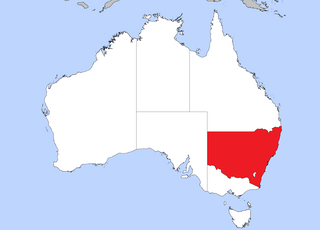
Cortinarius maculobulga is a species of truffle-like fungus in the family Cortinariaceae. Found only in New South Wales, Australia, it was described as new to science in 2010.
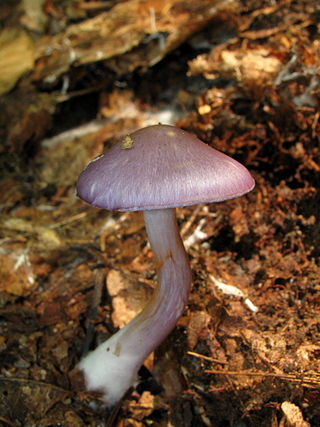
Cortinarius iodes, commonly known as the spotted cort or the viscid violet cort, is a species of agaric fungus in the family Cortinariaceae. The fruit bodies have small, slimy, purple caps up to 6 cm (2.4 in) in diameter that develop yellowish spots and streaks in maturity. The gill color changes from violet to rusty or grayish brown as the mushroom matures. The species range includes eastern North America, Central America, northern South America, and northern Asia, where it grows on the ground in a mycorrhizal association with deciduous trees. The mushroom is not recommended for consumption. Cortinarius iodeoides, one of several potential lookalike species, can be distinguished from C. iodes by its bitter-tasting cap cuticle.
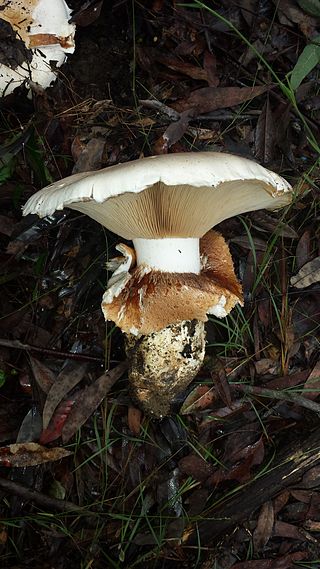
Austrocortinarius australiensis, commonly known as the skirt webcap, is a species of mushroom in the family Cortinariaceae which is native to Australia and New Zealand. The white mushrooms appear in autumn and can grow very large, with their caps reaching 30 cm (12 in) in diameter.

Cortinarius erythraeus, sometimes known as the Jammie Dodger, is a basidiomycete fungus of the genus Cortinarius native to Australia.

Cortinarius cyanites is a basidiomycete fungus of the genus Cortinarius native to Europe.

Cortinarius sanguineus, commonly known as the blood red webcap or blood red cortinarius, is a species of fungus in the genus Cortinarius.

Cortinarius kioloensis is a fungus native to Australia. It was described in 2009 by Alec Wood, and is related to the Northern Hemisphere species Cortinarius violaceus.
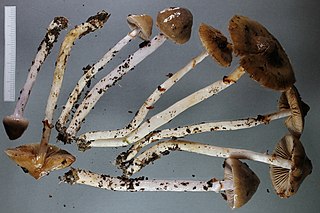
Cortinarius cucumeris is a basidiomycete fungus of the genus Cortinarius native to New Zealand, where it grows under Nothofagus.

Calonarius osloensis is a species of fungus in the family Cortinariaceae.
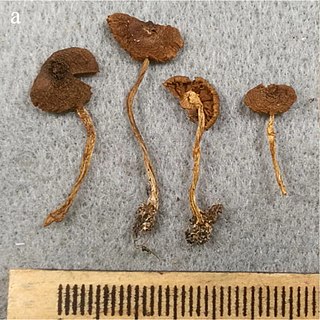
Cortinarius subsaniosus is a species of webcap mushroom known from north and central Europe, where it grows on sandy soil in association with willows. It produces small yellowish brown mushrooms. The species was described in 2020 by Kare Liimatainen and Tuula Niskanen. Its name refers to its affinity to C. saniosus, to which it is closely related. Along with five other British webcaps, C. subsaniosus was selected by Kew Gardens as a highlight of taxa described by the organisation's staff and affiliates in 2020.
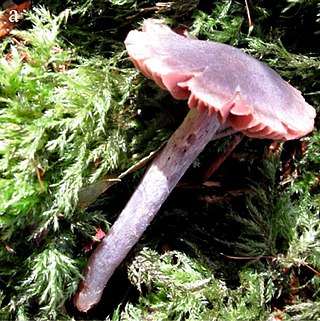
Cortinarius britannicus is a species of webcap. It is known only from Scotland, where it was found on clay soil among mosses under beech. The species produces small, purplish mushrooms. Along with five other British webcaps, C. britannicus was selected by Kew Gardens as a highlight of taxa described by the organisation's staff and affiliates in 2020.